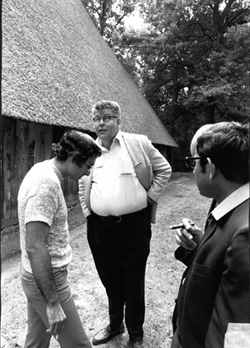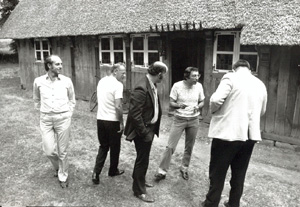|
Darin aber zeigt sich der vollkommene Stil in jeglicher Kunst, daß
er die spezifischen Schranken derselben zu entfernen weiß, ohne doch ihre
spezifischen Vorzüge mit aufzuheben, und durch eine weise Benutzung ihrer
Eigentümlichkeit ihr einen mehr allgemeinen Charakter erteilt.
Friedrich Schiller -Ober die ästhetische Erziehung des Menschen. In
den Horen, 22. Brief (1795)
We are glad that you have all come to this small village and I hope that
you will feel at home here for the next few days. The special atmosphere
of the surroundings will probably have a good influence on our discussions,
and you will perhaps remember this when you are back home again. It takes
hard work to save this little piece of nature for man in our highly industrialized
world, and we should all be grateful to the Verein Naturschutzpark e.
V. (founded in 1909), Alfred Toepfer and his associates for their efforts.
We intend to discuss modern trends in human leukemia in this workshop,
but we should also take the opportunity to reflect on the trends of the
past, which might still be modern. Rudolf VIRCHOW was the first using
the name " leukemia" to express that this was a disease sui generis. About
125 years ago VIRCHOW wrote the following words: "This is what we know
about leukemia: During normal blood cell production the cells differentiate
into specific types. In a pathologic situation the differentiation into
specific cells is blocked. This disturbance of normal differentiation
-so called leukemia- is a disease sui generis. We know the sequels of
this disease, but we don't know its origin. As yet there has been no successful
case of complete cure." It is perhaps depressing and certainly a challenge
that these words are today as true as they were in 1849, when they were
written. In fact, the origins of human organic sickness are now as unknown
as before. We can, however, help the patient better than we could a few
years ago. Besides cytostatic therapy and supportive care, the personal
efforts of the doctors themselves are the most important factor of therapy.
As long as there is no leukemia-specific therapy as well as a specific
therapy of other cancers, early diagnosis of the disease appears tO be
very important. Despite of the progress in morphologic techniques, the
sensitivity of leukemia diagnosis is not much better than 80 years ago,
when Paul EHRLICH developed his staining technique. Leukemia is usually
diagnosed when it can be recognized in the bone marrow, i. e. when there
are more than 1012 leukemic cells in the patient. But this is already
too late. The reason for this late diagnosis is that leukemic cells cannot
be distinguished morphologically from normal stem cells. Two years ago,
when we had our first workshop on modern trends in human


Frederick Stohlman, .Jr. in the garden of "De Emhoff" during a pcrsonal
discussion (first workshop. June 1973). Foto: Moldvay (STERN-Magazin)
|

